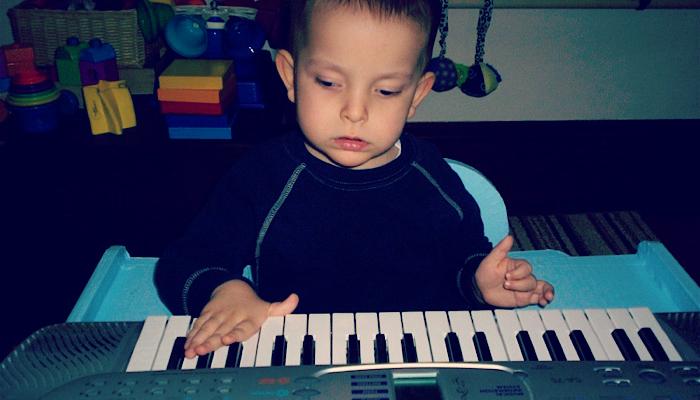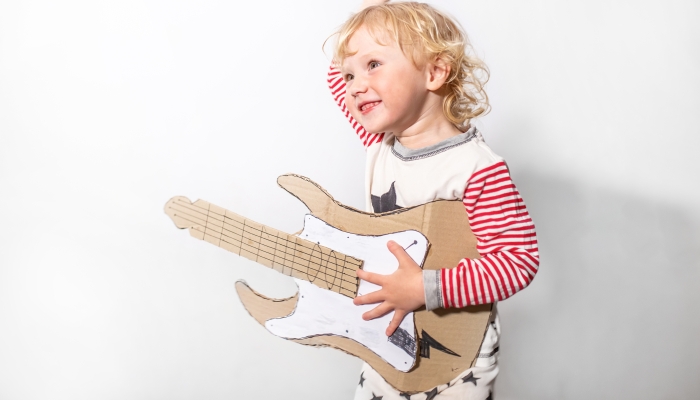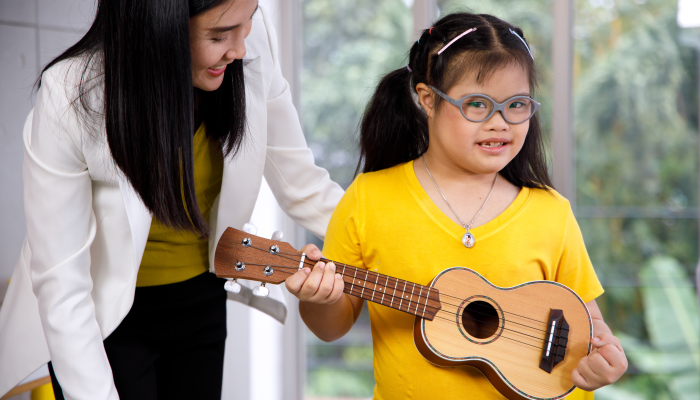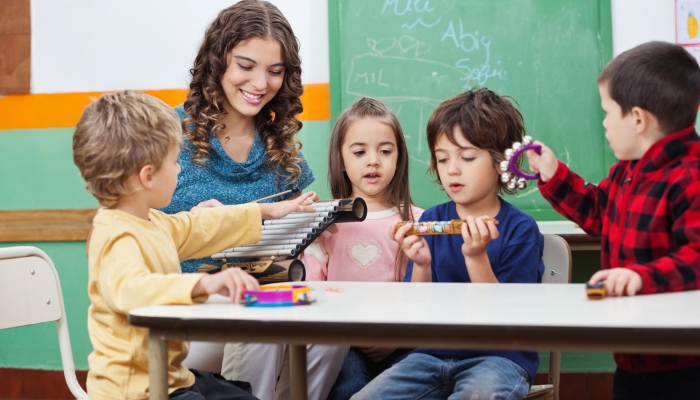Music & Development: Musical ways to engage developmentally disabled children

This post may contain affiliate links; please see our terms of use for details.
Maybe you’ve noticed that your child really responds to music and you want to harness that energy or maybe you’ve heard of Music Therapy and want to know more about it.
Then again, maybe your child already receives Music Therapy services and you’d like to bring more music into your home to help encourage your child’s development.
Either way, you may be looking for ideas on exactly how to use music at home. Simply listening to a CD or singing a song with your kid, while fun and certainly enjoyable for you both, isn’t quite getting you the response you want.
In this article we’ll explain what Music Therapy is, why it’s an important part of your child’s arsenal of services, and how you can enhance your child’s life at home by including more musical activities.
What is Music Therapy?
Music Therapy is not teaching your child how to sing perfectly (like Maria in The Sound of Music) or how to play an instrument.
Music Therapy is using music interactively and purposefully to open your child up to new experiences and concepts.
Music can facilitate:
- attention
- recognition
- communication
- anticipation
- fine and gross motor skills
- social skills
- patterning (such as counting or pre-reading skills)
- fostering memories
- self-esteem
Music can also be a great rehabilitation booster. One WonderBaby reader, Kellie, sent us video of her daughter Zoe receiving Music Therapy after a bone marrow transplant. She was the most alert and active during these sessions. As Kellie puts it:
The music therapy sessions were truly magical in terms of how they seemed to lift her spirits and her energy levels. She learned about tapping her hands in time with the music as a direct result of these sessions. Anytime we would sing the songs she learned during her sessions she would immediately begin beating her hands on whatever was nearby.
Here’s the video:
Incorporating music into your child’s learning and play is a great way to boost their development, but keep in mind that this is not the same as Music Therapy. Music Therapy, when applied by a trained therapist, is very complex and, as Suzanne B. Hanser writes in The New Music Therapist’s Handbook, “it is also based upon scientific principles, objective observation and systematic assessment of the person’s needs.”
If you want to learn more about Music Therapy or are trying to locate a therapist in your area, check out the American Music Therapy Association or the Certification Board for Music Therapists. If you’re looking for a music therapist in the Greater Boston area, you can check out the program at Jammin’ with You.
Along with the Music Therapy your child receives at school or through Early Intervention, you can also bring more music experiences into your home. Music is never something that can only be left to the professionals!
And remember, you can always ask for Music Therapy in your child’s IEP!
But I can’t sing or play any instruments! How can I do this at home by myself?
First of all, you can sing! We can all hum or sing or just be goofy with sounds once we let our guard down. Kids are great at this, but adults often lose that self-esteem and replace it with stuffy composure. Let yourself be yourself!
(Bill Harley has a terrific song about this called Grownups Are Strange.)
It’s also a great example for your kids. Teach your children that you can make music and that your family is musical.
What are some things I can do with music to encourage my child’s development?
Music is fun and easy. Get some kids’ CDs, learn a few rhymes, and maybe invest in a few simple instruments and you’re ready to go!
- Teach your child about different textures.
Take them in the kitchen and pull out plastic bowls, metal pots, and wooden spoons. Make lots of noise while you talk about how each item feels. - Improve fine motor skills.
Some instruments, like drums, are very easy to play: Just give it a good smack and you’ll get sound out of it. Others, like pianos or guitars, take a little more work. Help your child learn to isolate their fingers as they press the keys on the piano or move their fingers to strum the guitar. This improves hand strength and coordination. First Act makes some very sturdy yet affordable children’s instruments. - Use your breath.
Blowing can actually be a very hard skill for some kids to learn, but it’s a lot more fun when you receive instant feedback through a harmonica or recorder. Playing with these types of instruments can help your child learn to control their mouth better and thus can help facilitate both eating and speaking. - Match objects with songs.
Sing the “Itsy Bitsy Spider” while playing with a large toy spider or sing “Old MacDonald had a Farm” while pressing the buttons on an animal sound book (like Sounds on the Farm). Sure, they aren’t touching a real spider (ew!) or real animals, which is always the ideal teaching method, but it is a way to start pairing words with models and building on concepts. - Do the hand movements together.
A lot of kids’ songs come with hand movements (like the “Itsy Bitsy Spider” or “Ram Sam Sam”). Help your child do the movements so they can learn what everyone else is doing. The movements are social and involve reaching out, which can be hard for some kids with vision impairment to undertake on their own. Can’t remember the hand motions to your favorite rhymes? Check out these nursery rhyme videos. - Act out the words.
If a song has the words “Up, up, up!” then have your child reach up; When you sing “Down, down, down,” reach down. It’s another way to engage them with the concept. - Play music games.
Music can be a great way to get kids to play with others, even if the game is very, very simple. You can begin just by taking turns: You tap the drum, then your child taps the drum. Move up to more complicated songs that give directions, like the “Hokey Pokey” or “Ring Around the Rosey.” - Use music to motivate.
Music is also a wonderful motivator. If your child has trouble standing, for example, see if they will stand at a large drum or toy piano set on a chair. They just may surprise you by standing longer than usual because they are so excited about the feedback they are getting from the instrument. - Encourage communication.
Sing simple rhyming songs with your child (like “Mary Had a Little Lamb”) and leave out the last word. Try to get your child to fill in the blanks. - Walk to the beat.
If you’re trying to teach your child how to walk, pick songs with good rhythm and try walking to the beat (We like Raffi’s Walk, Walk, Walk). - Memorize.
People have been using songs to remember things for centuries. You can sing traditional rhymes to teach things like the months of the year (“Thirty Days Hath September”) or even make up your own simple songs to learn things like the names of your family members. Yes, you can make up your own songs!


Hopefully you’ll see some activities here that will work well with your child, and hopefully as you experiment with music you’ll develop some of your own! Just relax, have fun, and sing!
Read this article in Spanish: Lea este articulo en Español
Read this article in Arabic: قراءة هذا المقال بالعربية

Related Posts

Music Play
5 Fun DIY Musical Instruments for Kids
Looking for a rainy day activity you can do on a budget? Get your little rock stars into these easy, crafty DIY musical instruments with stuff you have at home.

Autism, Music Play
6 Ways Music Therapy Can Support Children With Autism
By harnessing the power of music, autistic children can develop communication, social, emotional, cognitive, and motor skills. Here’s how!

Music Play
Music and Movement: Enhancing Preschool Learning Through Songs
Music and movement activities for preschoolers can help enhance their cognitive skills and brain development while developing social, emotional, and academic skills.